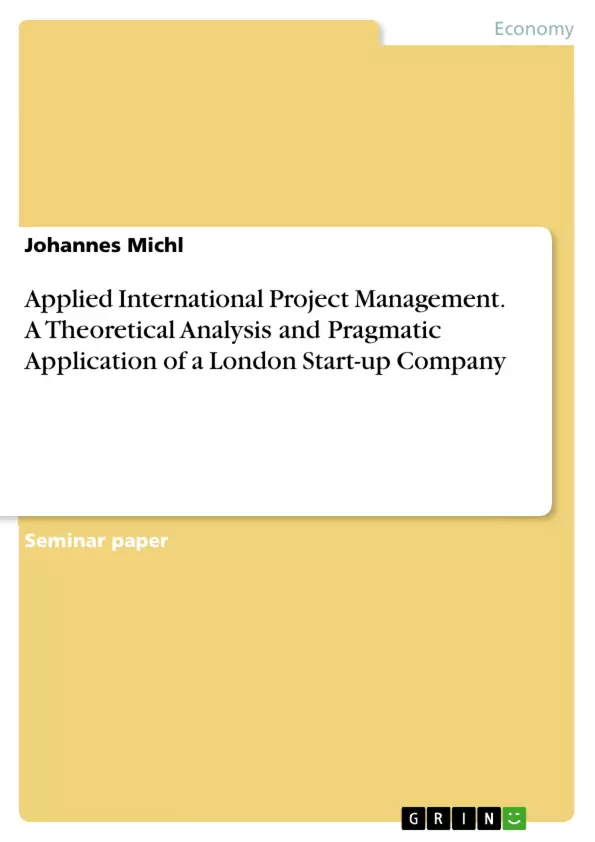The goal of this paper is to evaluate international project management at XY and to make recommendations for a better project cooperation. Therefore, first the typical project management approach at this company is examined. In a second step problems and weaknesses of the process are identified, to present in a third step possible solutions.
This paper the project management approach of XY is described from the perspective of the author. For a higher degree of detail one would have to question more employees of the company who participated in projects. Moreover, when having a look at the cultures, not all of the cultures that are found at XY are considered, because that would exceed the scope of the pa-per. Certain cultures are selected to make a point clear. Lastly it also was not tested whether or not the recommendations are practical.
In chapter two, the company XY is briefly introduced. A larger version of the organizational chart of the firm can be found in the appendix A. The subsequent third chapter presents the current project management approach at XY. This process is divided into: project initiation, project planning, action and control and finishing the project. The fourth chapter points out problems related to the project management approach and additional cultural and language specific problems. The cultural Indexes, which help to categorize the cultures, can be found in the appendix. The recommendations for improvement are described in chapter five. The paper is completed in chapter six with a conclusion.
For the preparation of this paper, primarily textbooks were used, which can be found in the appendix listed alphabetically. More knowledge was obtained from websites. Lastly the experiences of the author at a six-month internship at XY were essential to describe the project work there.
Inhaltsverzeichnis (Table of Contents)
- Introduction
- Objectives
- Scope
- Structure of the Paper
- Methodology
- Introduction of the Company
- Current Project Management Approach
- Project Initiation
- Project Planning
- Action and Control
- Finishing the Project
- Project Problems
- Project Set-up Within the Organisation
- Language
- Culture
- Recommendations for Improvement
- Weekly 5 Minute Country Presentation
- Language Courses or Tandem
- Time Management Course
- Daily Scrum
- Implement Lessons Learned
- Conclusion
Zielsetzung und Themenschwerpunkte (Objectives and Key Themes)
This paper aims to evaluate international project management at XY and provide recommendations for enhanced project cooperation. It examines the company's typical project management approach, identifies problems and weaknesses, and presents potential solutions.
- Analysis of XY's project management approach
- Identification of challenges related to project management
- Exploration of cultural and language barriers in project settings
- Proposal of recommendations to improve project cooperation
- Evaluation of the effectiveness of the current project management methodology
Zusammenfassung der Kapitel (Chapter Summaries)
- Introduction: This chapter sets the stage for the paper by outlining its objectives, scope, structure, and methodology. It clarifies the purpose of the analysis and the approach taken.
- Introduction of the Company: This chapter provides an overview of XY, a London-based company specializing in social media influence intelligence. It describes the company's mission, size, operations, and the challenges it faces in a dynamic market.
- Current Project Management Approach: This chapter delves into the typical project management process at XY, dividing it into four phases: initiation, planning, action and control, and completion. It analyzes how these phases are implemented within the company's context.
- Project Problems: This chapter identifies challenges related to the project management approach at XY, including organizational structure, language barriers, and cultural differences. It examines how these factors impact project success.
- Recommendations for Improvement: This chapter presents specific recommendations for addressing the identified problems and improving project cooperation. It suggests measures like language training, cultural sensitivity workshops, and improved communication strategies.
Schlüsselwörter (Keywords)
This paper focuses on international project management, specifically within the context of a London-based start-up company. Key themes include project initiation, planning, execution, control, and project closure. The paper also explores cultural differences, communication barriers, and the impact of language on project success. The analysis draws on theoretical frameworks and practical experiences to provide a comprehensive assessment of the project management landscape at XY.
- Arbeit zitieren
- Johannes Michl (Autor:in), 2014, Applied International Project Management. A Theoretical Analysis and Pragmatic Application of a London Start-up Company, München, GRIN Verlag, https://www.grin.com/document/300887



